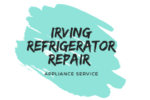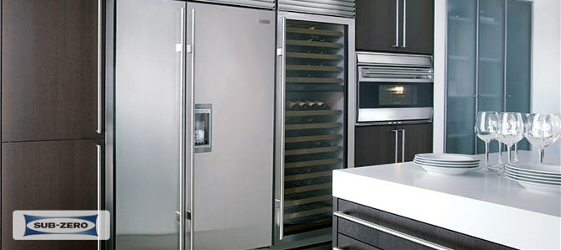Interesting article from the book called “Repairing Appliances” by “Time Life Books”. Excerpt from the book for our users. How to keep a refrigerator cool but frost-free is a challenging task for a old refrigerator. This article gives some techniques to refrigerator maintenance.
Between the old-fashioned icebox and the modern electric refrigerator stretch what seem to be light-years of mechanical and electrical advancement. Where once blocks of ice provided the chilling effect, today foodstuffs are cooled by refrigerant chemicals circulating through the connecting coils of an evaporator and a condenser. The refrigerant alternately absorbs heat and evaporates, becoming a gas, then cools and condenses, reverting to liquid form.
During the phase when the refrigerant is absorbing heat, water vapor inside the refrigerator collects as frost on the surfaces of the evaporator. For the refrigerator to function efficiently, this frost must be removed, and the three basic types of refrigerator are categorized by the manner in which this problem of frost removal is handled.
Of the three, the standard refrigerator, recognizable by its single exterior door and small, sometimes door less freezer compartment, defrosts only when you turn the unit off and allow the frost to melt. The cycle-defrost type, generally a two-door model, has a small heater that keeps the refrigerator compartment free of frost automatically. The freezer section requires manual defrosting, but because the freezer is separated from the refrigerator, the frost build-up is much slower than in a standard refrigerator. The freezer of a cycle-defrost unit needs defrosting only two or three times a year.
Frost-free refrigerators are designed to remove the frost from both compartments almost as soon as it forms. A heater in the evaporator turns on and a drain carries the water to a pan beneath the refrigerator, where it evaporates.
Although refrigerators, especially standard and cycle-defrost types, can function smoothly for years, good maintenance can prolong their life and increase their efficiency. Vacuuming around the condenser coils, for example, allows air to circulate freely and cool the coils. Dirty coils can cause the unit to run continuously or to stop altogether.
Cleaning the drain system of a frost-free refrigerator is also important. Both the drain hole and the drain pan tend to collect debris. In addition, keeping the drain pan clean stops odors from developing and prevents bacteria from growing. When you replace the pan, be sure it clears the compressor, or it will rattle each time the refrigerator switches on.
If the rubber gaskets that seal the refrigerator and freezer doors are cleaned regularly with soapy water, they should last the life of the refrigerator. But if the gaskets become cracked or torn, or if gaps form in the seal, they should be replaced. To check the tightness of the gasket seal, close the door on a dollar bill at several points around the frame; if you feel resistance as you pull the bill out, the seal is good.
Replacing a gasket is a major job. The screws that anchor the gasket also hold the inner door panel against the outer door-along with the door’s insulation. To avoid disturbing this assembly, the screws are simply loosened, not removed, and the old gasket is freed in sections. Each section is immediately replaced with a section of the new gasket, so that only a few of the screws are loose at any one time. New gaskets come molded to fit the dimensions of the door. They are packed in small boxes and should be soaked first in hot water to smooth out the crimps and to soften the stiff rubber.
Frost-free refrigerators are somewhat more prone to electrical malfunctions than standard or cycle-defrost models are, but some malfunctions are common to all three types. The button switch on the door, which turns on the interior light when the door opens, can wear out or break off, causing the light to stay on when the door is closed and increasing the interior temperature.
A refrigerator or freezer may not hold the temperature set by you on the control dial. If the cause is not dirt on the condenser coils or a deteriorated gasket, the thermostat probably is at fault. To check the temperature in a freezer, place a thermometer between two packages of frozen food; after 10 minutes the reading should be 0o to 10o F. To check the temperature in the refrigerator compartment, place a thermometer in a glass of water on the bottom shelf; after eight hours the reading should be 35o to 40o.
If the refrigerator runs constantly or cools poorly, the condenser fan may be at fault. Check first for dirty coils, then for an obstruction in the condenser fan-lost toys and other objects may become wedged between the blades and bring the cycle to a halt. If you find no obstruction, the fan motor itself should be tested for resistance.
Most electrical problems in frost-free refrigerators have to do with nonfunctioning phases in frost-removal cycle. If frost accumulates on the walls of the freezer section, first check the door switch that activates the evaporator fan. If the fan switch is not the problem, in spent the fan blades for ice; melt the ice by aiming a hair dryer, set on low heat, at the fan. If no ice is found on the fan blades, test the fan motor for resistance.
If everything in the operation of the evaporator fan checks out, from door switch to motor, examine the type of ice collecting of the evaporator coils. If the fins projecting from the coils are clogged with hard ice near the bottom, the drain system is clogged; if the coils are covered with white, fluffy frost, the problem is in the defrost timer, the heater or the defrost-limit switch.
To identify which of these components is malfunctioning, start the defrost timer manually and observe what happens. If the timer is defective, advancing it by hand will bypass the problem: The heater will come on, defrost the ice, and then turn itself off in 20 to 30 minutes. A faulty timer must be replaced. If the heater does not come on when the timer is advanced, test the heater for resistance. If the heater shows proper resistance, it is the defrost-limit switch, by elimination, that is at fault and must be replaced.
Although refrigerators vary in design, their mechanical and electrical parts usually function identically. Replacement parts should always be an exact match of the original, identified by model number Also, though most refrigerator repairs require standard tools, some need special tools and special precautions. Leaks in the tubing of the evaporator or compressor should be left to a trained technician. So should the replacement of a compressor. A faulty compressor, in fact, may signal the end for the refrigerator. It may be better economy to invest in a new refrigerator than in a new compressor.
Continue reading about “Ice Maker Repair in Irving”


